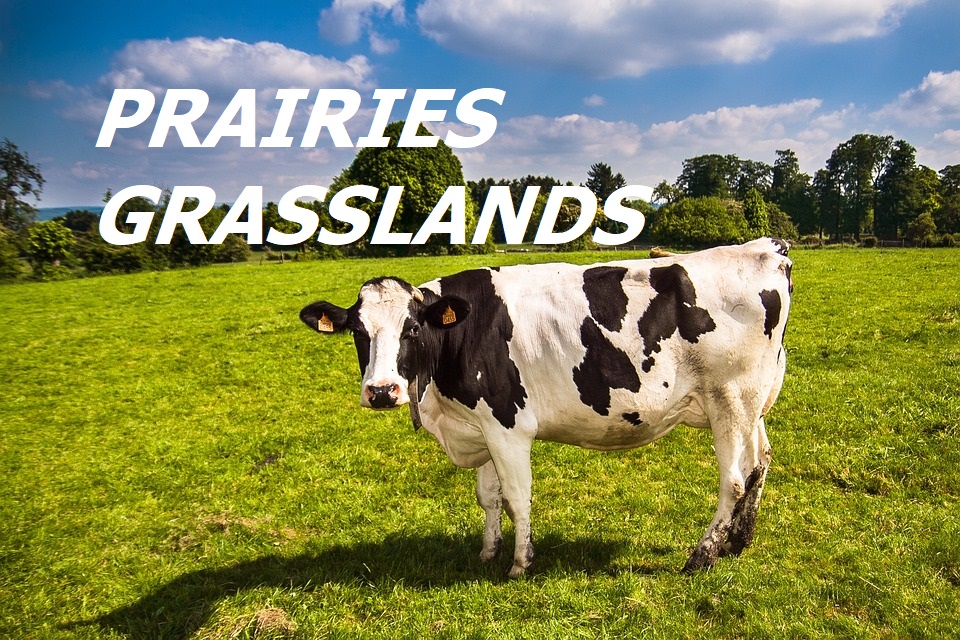What makes Prairies Grassland So Distinctive Ecosystem?
What makes Prairies Grassland So Distinctive? Yes, this question crops in my mind very often. Prairies are also known as the wheat Basket of the world. The vast stretches of Grass, plain and fertile land, climate, and it’s flora and fauna, all make this place a distinctive ecosystem. This diverse ecosystem supports a wide variety of plants and animals. They are home to many species of grasses such as big bluestem, little bluestem, switchgrass, and buffalo grass.
In particular, the Prairies Grassland, which runs from Canada to Texas, is where they are most frequently seen in North America’s interior.
Flora and Fauna In Prairies Grassland
The various ecosystems of prairie grasslands are home to a vast range of plants and animals.
Many grass species, including switchgrass, buffalo grass, tiny bluestem, and big bluestem, can be found there.
The prairies are also a haven for wildflowers like prairie clovers, black-eyed Susans, and coneflowers.
Several famous animals, such as the bison, pronghorn antelope, coyotes, and prairie dogs, can be found on the prairie.
Prairie ecosystems have evolved to withstand a combination of recurring fires, droughts, and huge animal grazing.
Kaziranga National Park Project – How To Complete In Just Three Hours?
The geographical location of Prairies Grassland
The Prairies Grassland is a sizable area of grasslands that spans parts of Canada and the United States in central North America.
The Great Plains, which run from the Rocky Mountains in the west to the Mississippi River in the east, are a portion of the Prairies
Grassland region in the United States.
The Prairies Grassland region is mostly found in the Canadian provinces of Alberta, Saskatchewan, and Manitoba, and it spans
a sizable portion of the middle and southern regions of these states.
Moreover, the area is distinguished by its level topography, open grasslands, and distinctive climate, which is characterized by hot summers
and cold, precipitation-light winters.
The climate of Prairies Grassland

The Prairies Grassland has a climate that is characterized by hot summers, cold winters, and little annual precipitation.
With temperatures ranging from -40°C to 40°C (-40°F to 104°F) depending on the season and location, the area has a semi-arid to sub-
humid climate.
Winters are often cold and snowy, with temperatures frequently falling below -20°C (-4°F), while summers are typically hot and dry with
temperatures frequently exceeding 30°C (86°F).
The region experiences only modest yearly precipitation, with most of it falling between 10 and 20 inches throughout the summer.
Therefore, little precipitation and sharp temperature swings combine to create a hostile environment for plant and animal life that has
shaped the distinctive ecosystems.
What makes the Prairies region so distinctive?
The Prairies region is known for its vast stretches of open grassland, rolling hills, and seemingly endless skies.
Here are some of the factors that make this region so distinctive:
Geography
Firstly, the Prairies region is located in the central part of North America and stretches across Canada and the United States.
It is characterized by its flat to rolling terrain, with very few trees and a semi-arid climate.
Agriculture
Secondly, the Prairies region is one of the most fertile agricultural areas in the world, with large-scale farming and ranching activities
dominating the landscape.
Moreover, the region is also known for its production of wheat, canola, barley, and other grains, as well as for its livestock and dairy farms.
Indigenous Culture
Thirdly, the Prairies region has a rich history of Indigenous culture, with several communities living in the area for thousands of years.
Moreover, these communities have developed unique cultural practices, including traditional arts and crafts, music, and spiritual beliefs.
Wildlife

WILD BISON FOUND IN PRAIRIES
The Prairies region is home to a diverse range of wildlife, including bison, elk, pronghorn antelope, and various bird species.
This wildlife is an important part of the region’s identity and is protected through national parks and wildlife reserves.
The Story Of Wildlife Conservation By Bishnoi Has Just Gone Viral
Weather
Finally, the Prairies region experiences a range of weather conditions, from hot and dry summers to cold and snowy winters.
The region is also known for its extreme weather events, including thunderstorms, tornadoes, and blizzards.
These weather patterns have shaped the region’s culture and way of life.
Project On Tsunami: 13 Pages You Must Include In Your Disaster Management Project
People and their main occupation in Prairies
The provinces of Manitoba, Saskatchewan, and Alberta make up the Prairies, commonly referred to as the Canadian prairies,
which is a region in Western Canada.
Following are some typical jobs in the area:
Agriculture
Due to the Prairies’ extensive farmland, agriculture is a prominent business in the area.
In addition to raising livestock like pigs and cattle, farmers and ranchers also grow crops like wheat, canola, and barley.
Oil and gas
The Prairies are also the site of sizable natural gas and oil deposits, which makes the extraction and production of these resources a key
industry in the area.
Manufacturing
The Prairies, with their expanding population and robust economy, have a booming manufacturing sector that creates a variety of goods,
such as machinery, transportation equipment, and food items.
Healthcare
The Prairies, like many other areas, place a high value on healthcare, with many residents working in hospitals, clinics, and other healthcare
facilities.
Education
The Prairies have a robust educational system, and the area is home to numerous institutions and colleges.
Throughout the educational sector, support staff, teachers, and professors all hold significant positions.
Education and Poverty: A Project to Understand The Impact of Education On Economic Development
Construction
Construction is a prominent business in the Prairies due to the region’s expanding population and requirement for new infrastructure.
Builders & contractors work on a variety of projects, including building roads and bridges as well as residential and commercial constructions.
Mining
Due to the Prairies’ large mineral resources of potash, uranium, and gold, mining is a key business in the area.
Retail
With a thriving economy and an expanding population, the Prairies have a sizable retail sector.
Retail employees are involved in a variety of tasks, including supply chain management, sales, and customer support.
Steps Taken For The Conservation of Prairies grassland
Prairie grasslands are important ecosystems that support a variety of plant and animal species.
It provides various ecosystem services such as carbon sequestration, soil conservation, and water regulation.
Here are some steps that can be taken for the conservation of prairies grassland:
Conservation of Prairies grassland is important to maintain the unique biodiversity, cultural heritage, and ecosystem services it provides.
Here are some steps that can be taken for the conservation of Prairies grassland:
Protect and restore native grasslands
The preservation of native grasslands is essential for the conservation of biodiversity.
This can be achieved by establishing protected areas, implementing conservation easements, and promoting habitat restoration.
Promote sustainable land use practices
Promoting sustainable land use practices such as rotational grazing, conservation tillage, and reduced pesticide use can help maintain
healthy soils, improve soil quality and enhance ecosystem services.
Raise awareness
Educating people about the value and importance of grasslands and their biodiversity is essential for their conservation.
This can be done through various means, including outreach programs, workshops, and educational materials
Protecting and Restoring Native Prairie Habitat
This involves identifying and protecting remaining prairie grasslands and restoring degraded or converted grasslands to their natural state.
This can be done through a variety of conservation practices, such as prescribed burns, seeding native grasses and forbs, and controlling
invasive species.
Encouraging Sustainable Grazing Practices
Grazing can be an important tool for maintaining healthy prairie grasslands, but overgrazing can lead to soil erosion and loss of biodiversity.
By encouraging sustainable grazing practices, such as rotational grazing, land managers can ensure that prairie grasslands are not degraded.
Controlling Invasive Species
Invasive species can outcompete native species, reducing biodiversity and altering ecosystem processes.
Controlling invasive species, such as cheatgrass and leafy spurge, is an important step in conserving prairie grasslands.
Promoting Sustainable Agriculture
Agriculture can have a significant impact on prairie grassland.
Therefore, by promoting sustainable agriculture practices, such as reduced tillage and cover cropping, land managers can help reduce soil
erosion and nutrient runoff, while also promoting soil health and biodiversity.
Supporting Research and Monitoring
Research and monitoring can help identify threats to prairie grasslands and evaluate the effectiveness of conservation practices.
Moreover, by supporting research and monitoring efforts, land managers can make informed decisions about conservation strategies and
adapt their approaches as needed.
Conclusion:
Overall, the conservation of prairie grasslands requires a multifaceted approach that involves protecting and restoring habitat, promoting sustainable land use practices, controlling invasive species, and supporting research and monitoring efforts the Prairies region is characterized by its wide-open spaces, unique geography, and rich history and culture, all of which contribute to its distinctive identity.
Hope, you must have found this post interesting and useful. I have a question for my readers which you have to answer in the comment box.
Question: Where are Shola Grasslands found?





0 Comments